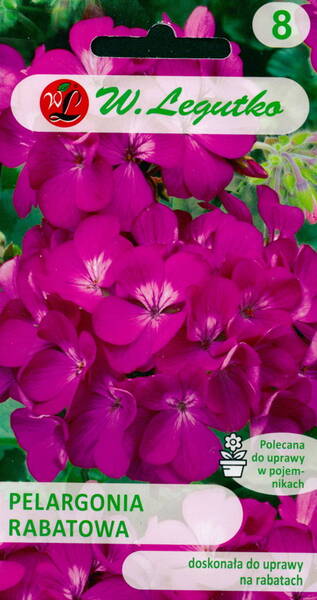Great compact shape.
Plants about 30 cm high. Flowers up to 2.5 cm in diameter, violet-purple.
Ideal for potting, and in summer can be planted in open ground and balcony boxes.
1,0 g = 150-200 seeds.
Agrotechnics.
The plant is drought-resistant, prefers a sunny location and loose, fertile soils. Sowing can be carried out starting in January. The seeding depth is 0.5 cm. The planting container is covered with glass and placed in a lighted place. At a soil temperature of + 20 ° C, seedlings appear on the 7-10th day. In the phase of 2-3 true leaves, the seedlings dive. For better tillering, the seedlings are pinched over 5-6 leaves.
* Seed propagation of pelargonium is very beneficial: despite the comparative high cost of seeds, they have a high germination capacity and allow you to get a large number of seedlings.
Compact, beautiful bushes with an abundance of large flower caps grow from the seeds.
The seeds of pelargonium are large, covered with a dense leathery membrane. It takes 5-6 months from sowing seeds to the beginning of flowering.
Pelargonium seeds can be sown throughout the year with additional lighting in autumn and winter. Usually amateur flower growers celebrate pelargonium from November to April. It is best to sow pelargonium in February-March (by the time of germination and the beginning of seedling growth, the length of daylight hours increases).
The soil for sowing pelargonium should be loose, moisture and air permeable. To compose the substrate, you can use high-moor peat, perlite, leaf and humus soil, sand.
For sowing pelargonium seeds, experts recommend the following composition of the substrate: sod land, sand and peat in a 2: 1: 1 ratio. Before sowing, it is advisable to disinfect the substrate (you can spill it with a pink solution of potassium permanganate, a solution of the biofungicide "Fitosporin-M"), because Pelargonium seedlings are susceptible to "blackleg" disease.
To accelerate the germination of the collected pelargonium seeds, experienced florists carry out their scarification (they are rubbed with fine-grained emery paper to remove the integumentary scales and slightly disturb the integumentary membrane). Seeds prepared for planting germinate in 7-10 days, and without pre-sowing treatment, their germination is not friendly and can take up to 3 months.
Seeds that have already been cleaned of the integumentary scales go on sale, they germinate in 2-3 weeks.
Pelargonium F1 hybrids grown from seeds can only be propagated vegetatively in the future, because the seeds obtained from them will give splitting in subsequent generations (the plants grown from them will not look like their mothers).
Seeds formed on varietal pelargoniums under favorable growth conditions as a result of artificial pollination, insect pollination or self-pollination can be used for sowing. They are harvested from plants in summer or early autumn, after the seed pods are brown.
Pelargonium seeds are sown in boxes and bowls filled with a moist substrate, sprinkled with a thin layer of substrate or sand 2-5 mm thick, sprayed on top after sowing and cover the bowl with glass. Every day it is required to ventilate the seedlings by lifting the glass and wiping it from condensation.
For the germination of pelargonium seeds, it is required to maintain a temperature of + 18 + 22 ° C and regularly moisten the drying substrate. A dish with emerging seedlings is placed in a bright place; with sufficient light, the seedlings grow strong and stocky, and develop quickly.
After emergence, it is important to maintain moderate soil moisture and prevent it from drying out, protect the seedlings from direct sunlight, gently loosen the soil and ventilate the seedlings. After 1-1.5 months, when 2-3 true leaves are formed in the plants, the seedlings of pelargonium are picked into pots, while it is important to plant the plants at the same depth at which they grew earlier. The optimum growth temperature is + 16 + 20 ° С. For better tillering, pinch pelargonium seedlings over 5-6 leaves. The abundance of light and fresh air promotes good growth and constant flowering of pelargoniums.
Eng.: Horseshoe pelargonium. Suom.: Pelargoni, Zonale-ryhmä, Pelakuu, pielikki. Sven.: Pelargon Zonale-gr.
In some houseplant pots, the ground turned green on the surface. What should be done?
The reason for this is often excessive watering, poor earthen mixture (no coarse river sand or vermiculite), or your flowers lack light. In any case, remove the top layer of soil in pots, add washed dry sand and crushed charcoal, loosen the soil more often (carefully) with a stick, do not get carried away with watering (especially in autumn-winter time) - this is undesirable for most indoor flowers, and your green friends will rise.












